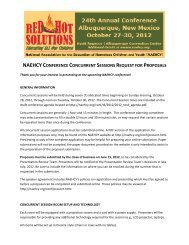The McKinney-Vento Act and Children and Youth ... - State of Michigan
The McKinney-Vento Act and Children and Youth ... - State of Michigan
The McKinney-Vento Act and Children and Youth ... - State of Michigan
You also want an ePaper? Increase the reach of your titles
YUMPU automatically turns print PDFs into web optimized ePapers that Google loves.
WHO ARRANGES TRANSPORTATION?<br />
<strong>The</strong> logistics <strong>of</strong> providing transportation to the school <strong>of</strong> origin require<br />
information <strong>and</strong> organization. Someone must request transportation. Schools<br />
must know where the child is living <strong>and</strong> must be informed immediately <strong>of</strong><br />
placement changes. In Pima County, AZ, the education agency <strong>and</strong> child<br />
welfare agency agreed that caseworkers would contact the homeless liaison<br />
to request transportation, <strong>and</strong> the liaison would make the arrangements.<br />
However, in practice here <strong>and</strong> elsewhere, caseworkers, group homes, <strong>and</strong><br />
foster parents all call to request transportation. This can create confusion <strong>and</strong><br />
delays in transportation.<br />
Child welfare <strong>and</strong> education agencies should establish, <strong>and</strong> follow, clear<br />
transportation procedures.<br />
WHO ANSWERS MCKINNEY-VENTO QUESTIONS?<br />
It is the responsibility <strong>of</strong> <strong>McKinney</strong>-<strong>Vento</strong> state coordinators <strong>and</strong> school<br />
district homeless liaisons to interpret the <strong>McKinney</strong>-<strong>Vento</strong> <strong>Act</strong> <strong>and</strong> explain<br />
it to parents, youth, <strong>and</strong> child welfare caseworkers. <strong>The</strong>y should be the state<br />
<strong>and</strong> local authorities on the <strong>Act</strong> <strong>and</strong> its implementation.<br />
However, as the child welfare system is a distinct agency with its own<br />
policies <strong>and</strong> hierarchy, some jurisdictions have found it helpful to designate<br />
staff within the agency to learn about the <strong>Act</strong> <strong>and</strong> respond to questions<br />
from caseworkers. This practice can also help prevent overwhelming state<br />
coordinators <strong>and</strong> homeless liaisons with questions related to youth in care<br />
<strong>and</strong> allow them to maintain the necessary focus on homeless children <strong>and</strong><br />
youth. <strong>The</strong> designated child welfare staff members should work closely with<br />
homeless liaisons <strong>and</strong> the state coordinator to ensure a clear <strong>and</strong> consistent<br />
underst<strong>and</strong>ing <strong>of</strong> the <strong>Act</strong>. One positive strategy would be for child welfare<br />
<strong>and</strong> education agency personnel to conduct <strong>and</strong> attend joint trainings <strong>and</strong><br />
respond to questions together for a period <strong>of</strong> time, before child welfare staff<br />
assume the responsibility <strong>of</strong> addressing questions alone.<br />
Connecticut’s Joint<br />
Memor<strong>and</strong>um on youth<br />
awaiting foster care<br />
establishes a procedure<br />
for addressing questions:<br />
“DCF staff members in Area<br />
Offices should consult with<br />
your Education Consultant<br />
or your Principal Attorney;<br />
Directors <strong>of</strong> STAR <strong>and</strong> SAFE<br />
Homes or Permanency<br />
Diagnostic Centers should<br />
contact your DCF liaisons;<br />
<strong>and</strong> Superintendents <strong>of</strong><br />
Schools may contact [the<br />
<strong>State</strong> Coordinator].”<br />
Despite this protocol, the<br />
state coordinator estimates<br />
that as many as 40% <strong>of</strong><br />
the calls he receives are<br />
in regard to youth awaiting<br />
foster care placement. This<br />
further demonstrates the<br />
importance <strong>of</strong> adequate<br />
capacity in the state<br />
coordinator’s <strong>of</strong>fice to meet<br />
the needs <strong>of</strong> all eligible<br />
students.<br />
Establishing the appropriate roles <strong>and</strong> authority <strong>of</strong> the adults involved in<br />
a youth’s life is only an initial step. Schools must be made aware <strong>of</strong> who is<br />
responsible for making decisions. <strong>The</strong> next section <strong>of</strong>fers strategies for schools<br />
<strong>and</strong> child welfare agencies to share this <strong>and</strong> other critical information.<br />
Strategies for Improving Educational Outcomes through School Stability 43














